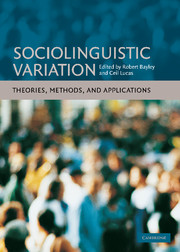Book contents
- Frontmatter
- Contents
- 1 List of figures
- 2 List of tables
- Acknowledgments
- Notes on editors and contributors
- Introduction
- Part 1 THEORIES
- Part 2 METHODS
- Part 3 APPLICATIONS
- 12 Sociolinguistic variation and education
- 13 Lessons learned from the Ebonics controversy: implications for language assessment
- 14 Variation, versatility, and Contrastive Analysis in the classroom
- 15 Social-political influences on research practices: examining language acquisition by African American children
- 16 Sociolinguistic variation and the law
- 17 Attitudes toward variation and ear-witness testimony
- Afterword: Walt Wolfram and the study of sociolinguistic variation
- References
- Index
13 - Lessons learned from the Ebonics controversy: implications for language assessment
Published online by Cambridge University Press: 16 February 2010
- Frontmatter
- Contents
- 1 List of figures
- 2 List of tables
- Acknowledgments
- Notes on editors and contributors
- Introduction
- Part 1 THEORIES
- Part 2 METHODS
- Part 3 APPLICATIONS
- 12 Sociolinguistic variation and education
- 13 Lessons learned from the Ebonics controversy: implications for language assessment
- 14 Variation, versatility, and Contrastive Analysis in the classroom
- 15 Social-political influences on research practices: examining language acquisition by African American children
- 16 Sociolinguistic variation and the law
- 17 Attitudes toward variation and ear-witness testimony
- Afterword: Walt Wolfram and the study of sociolinguistic variation
- References
- Index
Summary
Introduction
For a brief period at the end of 1996 and the beginning of 1997, an unprecedented number of people in the United States engaged in an impassioned and often acrimonious debate about a specific variety of English – Ebonics. The intense and sometimes heated discussions attracted nearly everyone: the young, the old, Whites, Blacks, teachers, preachers, poets, politicians, leaders, followers, and, predictably, language professionals – linguists and speech/language pathologists (SLPs). The debate provided an important opportunity for SLPs to refocus on a long-standing professional challenge: providing valid language assessments for speakers of Ebonics, or African American Vernacular English (AAVE).
Given the knowledge about Ebonics from several decades of impressive, convincing linguistic research, it is safe to say that practitioners have more than enough information to provide an adequate assessment of the language of African American children. We already know a lot about their phonological, syntactic, semantic, and pragmatic systems (although we can always learn more). In other words, we already know enough to determine whether an African American child's language is normal.
Why, then, are so many invalid assessments still being made and used to place African American children in special education and related services? During the Ebonics debate the Oakland Unified School District reported that a staggering 71% of the students enrolled in special education were African American. This figure suggests that professionals did not learn anything from the Black English trial that focused on eleven Ebonics-speaking children at the Martin Luther King Junior Elementary School in Ann Arbor, Michigan (Smitherman 1981, Rickford and Rickford 2000), where the children were placed in special education classes after language assessments failed to take into account their linguistic heritage.
Information
- Type
- Chapter
- Information
- Sociolinguistic VariationTheories, Methods, and Applications, pp. 254 - 275Publisher: Cambridge University PressPrint publication year: 2007
Accessibility standard: Unknown
- 4
- Cited by
